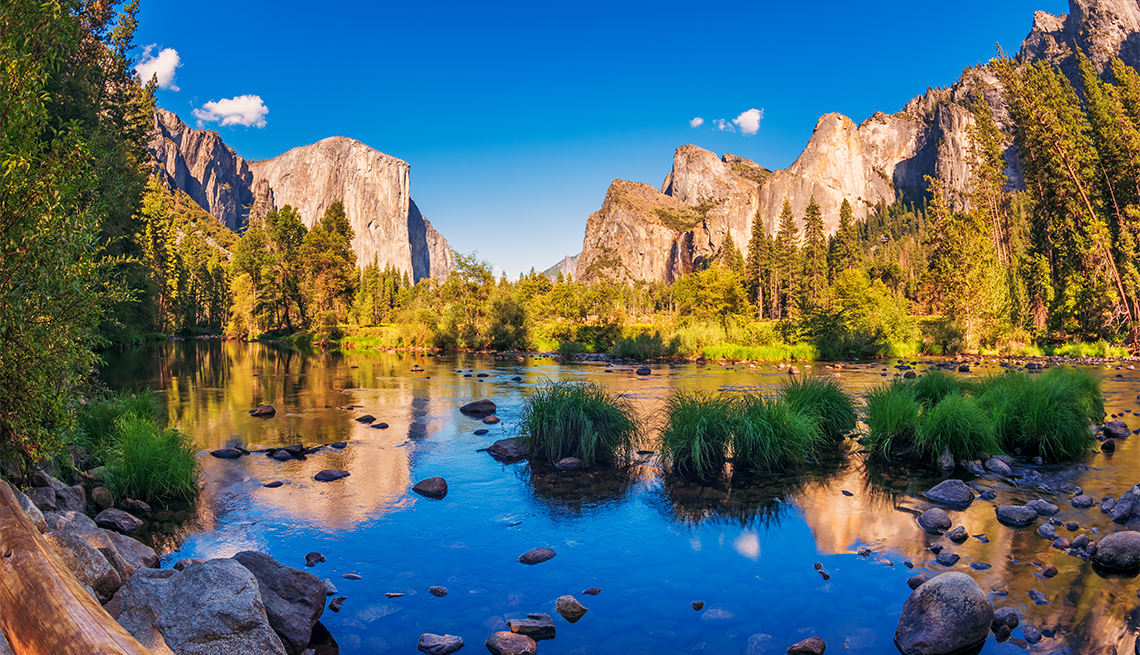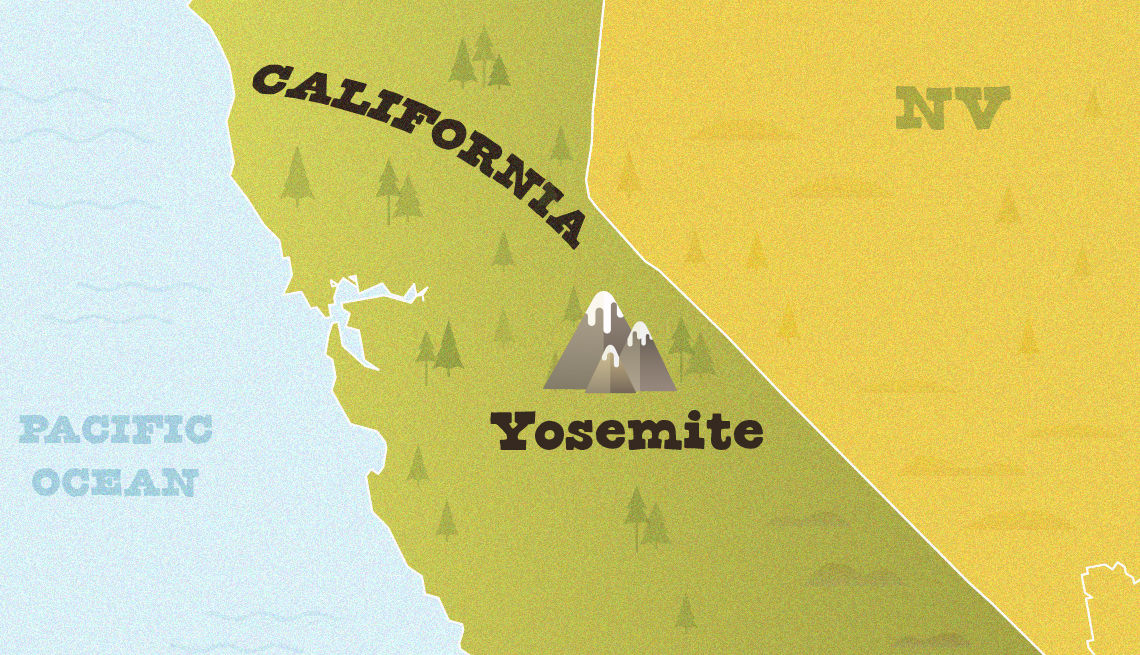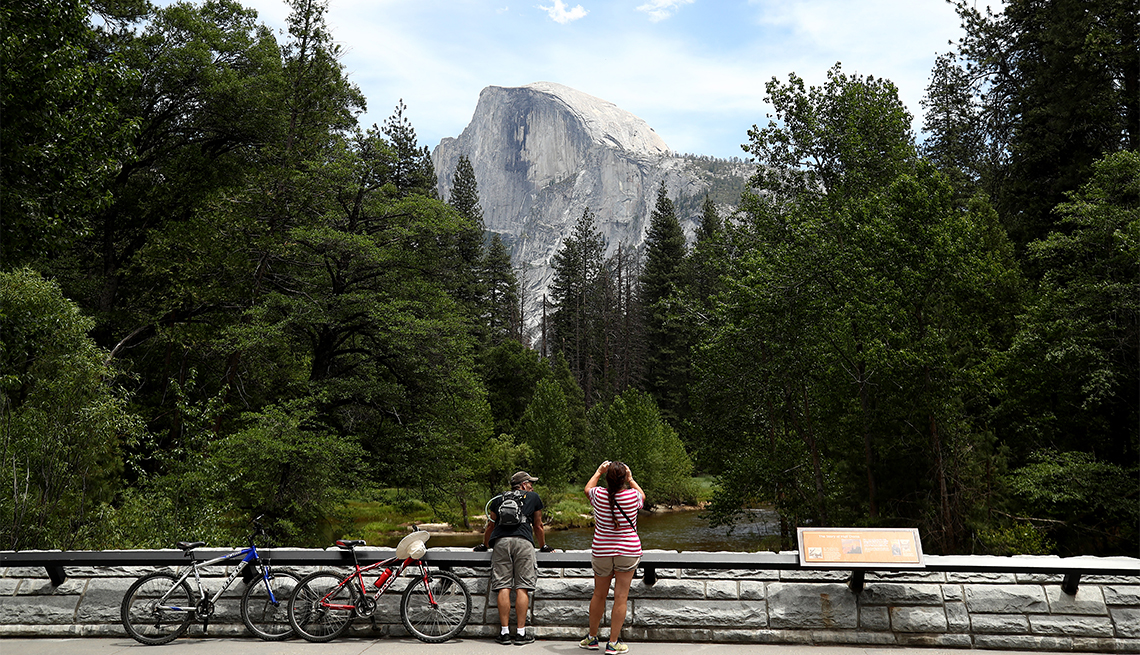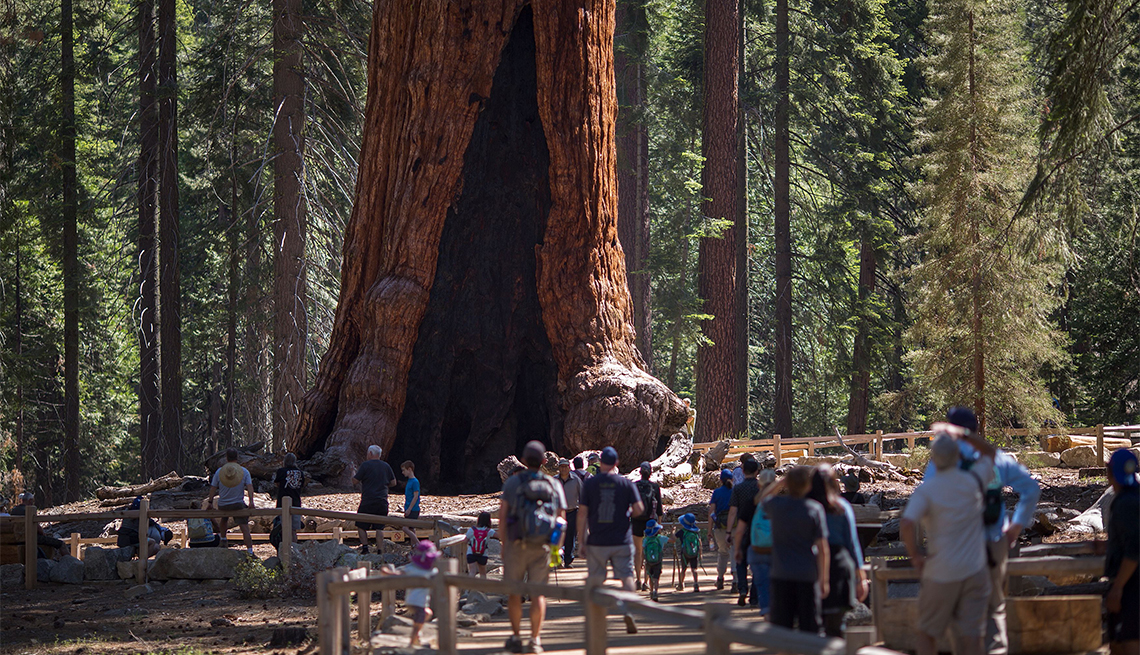AARP's Guide to Yosemite National Park
Giant sequoias, huge waterfalls, El Capitan call to naturalists and artists
En español | In eastern California's Sierra Nevada mountain range, Yosemite National Park covers nearly 1,200 square miles of glacier-carved hills and valleys, rivers and lakes and soaring granite cliffs. Home to some of the most impressive and iconic natural landmarks on Earth, the park teems with superlatives: Yosemite Falls, at 2,425 feet, one of the world's tallest; El Capitan's sheer 3,000-foot walls topping one of the world's largest monoliths; and Mariposa Grove, hosting the world's most massive forms of life, 3,000-year-old sequoias stretching 200 feet upward from 25-foot-thick trunks.
Given its beauty, the park has inspired famous naturalists, photographers and athletes. Naturalist John Muir wrote extensively about his travels in Yosemite, campaigning for it to become a national park, as it did with his help in 1890. “No temple made with hands can compare with Yosemite. Every rock in its walls seems to glow with life,” he wrote. Ansel Adams shot some of his most famous photos in the park, writing that “Yosemite Valley, to me, is always a sunrise, a glitter of green and golden wonder in a vast edifice of stone and space.” His old photo studio is now a gallery and store in the park. More recently, the mind-boggling El Capitan rock-climbing exploits of Tommy Caldwell and Alex Honnold inspired the popular documentaries The Dawn Wall and Free Solo.
But you don't have to be an extreme athlete or legendary artist to appreciate the best of Yosemite. Viewpoints of the famous sights are plentiful and easily accessible. Ranger-led tours and education programs enable you to dig deeper into the park's fascinating natural world, and you can experience its myriad activities — from hiking and biking to golfing and skiing — in your own way.
With 4.5 million visitors annually, the park is certainly no secret, with the Yosemite Valley tourist loop getting quite crowded in summer. But with 95 percent of the park designated as undeveloped wilderness, you can easily get off the beaten track and enjoy plenty of nature for yourself, particularly in the off-season.
Location: Eastern California
Acreage: 759,000 acres
Highest peaks: Mount Lyell, at 13,114 feet
Lowest point: Merced River, at 2,105 feet
Miles of trails: 800 miles (20 miles paved)
Main attractions: El Capitan, Half Dome, Mariposa redwoods, Yosemite Falls
Cost: $35 per carload, good for seven consecutive days (annual Seniors Pass $20)
Best way to see it: Walking to scenic viewpoints from shuttle buses
When to go to avoid the crowds: Winter and early spring
Plan Your Trip
Yosemite is about a 200-mile drive east from San Francisco and 300 miles northeast from Los Angeles. Some visitors arrive via airports at Sacramento (175 miles southeast) and Reno (150 miles south).
Access Yosemite from four entrances. The northwest Big Oak Flat Entrance on CA-120 (via Groveland), the western Arch Rock Entrance on CA-140 (via Mariposa), the South Entrance on Route 41 (via Oakhurst and Fish Camp) and the eastern Tioga Entrance on CA-120 via Lee Vining (closed from approximately mid-November through late May). Entry fee is $35 per vehicle (annual Seniors Pass, $20).
Most visitors focus on central Yosemite Valley, which has most of the lodging and facilities, as well as scenic roadside viewpoints of iconic landmarks, including El Capitan, Half Dome and Yosemite Falls. Because of this, it can get crowded during the summer high season, with excessive traffic, limited parking and lodging, and packed paths and viewpoints. Consider visiting in the off-seasons to avoid crowds and to get a different perspective of the park. Spring in Yosemite brings the largest waterfall volume and river flows, while fall boasts vibrant, colorful foliage in the valley, and winter provides a wonderland of silent, snow-covered meadows and mountain peaks. “The best time to visit the park, in my opinion, is mid-September through October. There are still long days, good weather, great leaf-peeping and none of the summer crowds,” says Scott Gediman, Yosemite public affairs officer and 24-year park resident.
A free shuttle bus system within the park travels three routes: the main road loop within Yosemite Valley; between the South Visitor Center and the Mariposa Grove of sequoias; and a link between the Valley and Tuolumne Meadows in the park's northern section.
Avoid traffic and parking hassles and save money by taking a bus to the park with YARTS. Four YARTS routes access the four entrances with regularly scheduled service from several gateway cities and hotels. Round-trip tickets range from $9 to $34 (with about a 50 percent discount for passengers 62-plus) depending on distance, and include entry to the park.
Cellphone and GPS coverage in the park is limited, so bring a paper map (available at all entrances) to help avoid getting lost without signal. Wi-Fi is available for guests at Yosemite hotels, as well as to the public at Degnan's Kitchen cafeteria in the Valley, and the park's two Mariposa County Library branches.
Yosemite has four diverse seasons of weather, and all four can happen in one day, given changing mountain conditions, so dress in layers. Summer temperatures can top 100 degrees at lower elevations in the valley and around Hetch Hetchy reservoir; winter brings lows in the 20s, sometimes with deep snow and road closures.
Where to Stay and Eat
You have plenty of lodging choices in and around the park, but reserve far in advance of the summer season, when accommodations fill quickly.
The Ahwahnee, the park's iconic property, delivers cozy luxury and awe-inspiring views of Yosemite Falls and the surrounding valley — at a hefty price, with its 97 rooms and 24 cottages renting from $600 a night ($495 in the off-season). For your money, you get a slew of amenities, including a window-lined, chandelier-topped grand dining hall serving classic prime rib dinners and its Great Lounge, with soft couches, a roaring fire and a classical pianist — a fine spot for cognac-sipping after a day outdoors. Its food and wine events in fall and winter are “particularly popular with the older demographic,” says Lisa Cesaro, its regional marketing director.
Take your pick of accommodations at Curry Village, a lodging hub at Half Dome Village with 403 canvas tent cabins (shared bath facilities), 61 cabins and 18 motel rooms. Purchase groceries and essentials at its market and dine at nearby restaurants, including Meadow Grill (breakfast burritos, burgers, rice bowls and salads) and Pizza Patio.
Tuolumne Meadows Lodge, in Yosemite's central highlands, provides a base camp for hikers during summer with canvas-tented cabins and a tented dining hall serving hearty family-style meals.
Families and groups often favor the sprawling Yosemite Valley Lodge, a 245-room complex near the base of Yosemite Falls, for its affordable prices and larger-sized family and bunk rooms. Feast on steak and seafood and great views of the falls in its Mountain Room, while a food court serves up cafeteria-style cheap eats and a Starbucks.
About five miles beyond Yosemite's South Gate, “go back in time” says Cesaro, at the 104-room Wawona Hotel (built in 1856), a Victorian-style property with reasonable prices and popular summer weekend barbecues. (Note: closed for upgrades until summer 2021.)
For self-catering and extended stays, Scenic Wonders books more than 100 vacation rentals in and just outside the park — everything from rustic cabins and basic condo units to five-bedroom luxury homes.
Yosemite is a mecca for campers with 1,400 individual campsites at 15 campgrounds in large, sparsely wooded encampments in the valley and more remote high-country creek and lakeside retreats. But don't procrastinate: Campgrounds typically get booked solid for the summer — reserve at recreation.gov five months in advance — while limited first-come, first-served campgrounds typically fill by noon. The park permits RVs at nine campgrounds, none with hookups. Fees are $18-26 per night at campgrounds with tap water and restrooms, $6-12 at more basic areas. Backcountry camping requires wilderness permits ($5 per reservation plus $5 per person), with reservations taken 24 weeks in advance online, awarded through lottery during peak periods.
Note: Be very aware when camping; always store food securely to avoid encounters with Yosemite's voracious natives.
In addition to the dining at Yosemite lodging mentioned above, you can stop at Degnan's Kitchen in Yosemite Village for cafeteria food and snacks, with the BBQ-and-beer Loft above it. Stock up on picnic and camping supplies at the Village Store or at Wawona Store in the south and Tuolumne Meadows Store to the north.
Things to Do
Sightseeing: Every visitor must see “Yosemite's Greatest Hits,” as Gediman calls them, the iconic landmarks of wood, water and stone that define the park. From easily accessible roadside viewpoints and short, flat (and mostly wheelchair-accessible) paved paths in Yosemite Valley, gaze at the towering city-sized boulder that is Half Dome, nervously watch the climbers hanging from El Capitan's 3,000-foot-tall sheer cliffs and admire the cool, cascading waters of Yosemite Falls and Bridalveil Fall. In the park's southern edge, take a shuttle bus to walk a smooth boardwalk among 500 giant sequoia trees in Mariposa Grove. The ultimate roadside Valley viewpoint? The Tunnel View parking lot by Route 41 north of Wawona. Overlooking the falls, Half Dome and El Capitan, it's a perspective impressive enough to bring out the inner Ansel Adams from even the most jaded city dwellers.
Go sightseeing beyond the Valley and you'll discover more spectacular scenery. In northern Yosemite, see the shimmering waters of the Hetch Hetchy Reservoir and walk atop its towering dam. The Tuolumne Meadows area in Yosemite's central highlands boasts fields of wildflowers and the high-alpine Tenaya Lake, with white-sand beaches fronting its frigid blue waters. In the Crane Flat area in the park's western edge, escape the crowds for the lesser-visited Merced and Tuolumne sequoia groves and forest paths. Note: The popular road to Glacier Point sightseeing spots is closed through 2021 for repairs.
Hiking and other active pursuits: With 800 miles of trails, the park offers nearly infinite hiking opportunities. Whether you're backcountry camping in the harsh high alpine or taking a half-hour stroll through flat meadows, it's worth the effort to branch off from the paved paths of Yosemite Valley, but know your limits and be aware of changing weather conditions. Day hikes in Yosemite Valley and Tulomne Meadows are moderately difficult but rewarding ways to escape the crowds.
In Yosemite Valley, the Mist Trail begins near Curry Village, ascending 400 feet over about a mile to the Vernal Fall Footbridge. The uphill climb can be a workout at the 4,000-foot elevation, but the wide, paved path is accessible to anyone of reasonable fitness. You'll be rewarded for the effort with prime views of the roaring Merced River and Vernal Fall at the bridge, where restrooms and water are available. The motivated can continue another steep three-quarters of a mile to the top of the falls, then onward six miles to Half Dome.
In Tuolumne Meadows, hike the easy 1.5-mile flat gravel Soda Springs/Parsons Lodge trail to enjoy flowering alpine meadows — traverse a bridge over the Tuolumne River and watch bubbling water emerging from an underground spring. Artists and naturalists present summer seminars at the stone Parsons Memorial Lodge at the trail's end.
Aside from hiking, biking the 12 miles of flat paved trails around Yosemite Valley is probably the best way to access the most scenic viewpoints and facilities at your own pace. Kiosks by Yosemite Valley Lodge and Curry Village rent bikes (including ADA hand-crank and tandem ones) from March to November, weather permitting. From Wawona Stables, hop on a horse or mule for a two-hour guided tour. Take a rare opportunity to play golf within a national park at the nine-hole Wawona Golf Course (open from May to October) near the Wawona Hotel, or play tennis on the property's courts. At the Badger Pass Ski Area in winter, go cross-country and downhill skiing and snowshoeing. Guides also lead backcountry ski tours.
Learning: From the visitors centers, learn about geology, history and wildlife on regular free Yosemite Ranger Walk & Talks in hourlong tours (some wheelchair-accessible). For those with limited mobility, two- to eight-hour guided bus tours from Yosemite Lodge are a good way to get a park overview with easy access to the main sites. Or pick up a new skill in a painting or photography class — there's no better setting to do it in! Offered by the Yosemite Conservancy and the Ansel Adams Gallery, “these workshops have been really popular with the over-50 crowd,” says Gediman. For families, the Yosemite Junior Ranger and Wee Wild Ones programs get the kids and grandkids excited about nature.
AARP Membership -Join AARP for just $15 for your first year when you enroll in automatic renewal
Join today and save 25% off the standard annual rate. Get instant access to discounts, programs, services, and the information you need to benefit every area of your life.
Gateway Towns
Fifteen miles from Yosemite's South Entrance, in Oakhurst, you'll find mountain curio gift shops and a strip of chain motels, plus boating and fishing in nearby Bass Lake. Spoil yourself at the ultraluxurious Chateau du Sureau, with villas and suites fit for French royalty on a mountain estate southwest of town. Splurge on dinner at its Elderberry House Restaurant — think caviar service and duck breast and beef Wellington entrees. Back in town, grab simple pub grub and beers at the South Gate Brewing Company.
Just three miles from Yosemite's South Gate, the expansive Tenaya Lodge is another choice lodging in the area, with new cabins, villas and a hotel with multiple pools and restaurants set amidst a pine forest. A guest perk: customized open-top bus tours of Yosemite.
Between Oakhurst and the South Gate, go back in time and learn about the logging and mining past of the Sierra Nevada mountains on a Sugar Pine Railroad tour. Board an old steam train and chug along a restored railroad used by the Madera Sugar Pine Lumber Company to haul timber more than a 100 years ago.
In Mariposa, 32 miles from Yosemite's southwest Arch Rock Entrance, you'll find inexpensive lodging, a shop-lined main street, a nice regional history museum and nearby outdoor recreation, including easy shaded hikes and river play. Dine on house-smoked ribs at Woodys Indoor Outdoor Grub in a fun setting with outdoor games and live music. For fine dining, try the rack of lamb or stuffed chicken specialties at Charles Street Dinner House. You'll feel like you're in an old western at the Mariposa Hotel Inn (established 1901) with its six quaint, frilly rooms filled with historical photos, Native American artifacts and classic “Victorian Western” décor.
Just north of Mariposa, AutoCamp recently introduced a hip new luxury experience — “glamping” in 102 custom Airstream trailers, tents and cabins, all with firepits and patios spread in a forested area centered around an upscale clubhouse with pool.
Twenty-four winding miles from the northwest Big Oak Flat entrance takes you the old Gold Rush town of Groveland. Walking tours of its colorful Main Street (with street performers in summer) reveal its Wild West past, with stories about its old jailhouse, historic saloons, miners’ quarters and the shops and brothels that served them. Behind their historic exteriors, the Groveland Hotel (built in 1849) and Hotel Charlotte (built 1921) provide a modern Yosemite-themed lodging experience with reclaimed wood furniture and rustic décor, and amenities such as free Wi-Fi and even a Tesla charging station. Before leaving town for a hike, fuel up with filling burritos at the authentic, family-run Cochina Michoacana.
Just a couple miles from the Oak Flat gate, at the sister properties of the new Rush Creek Lodge (with hotel, villas, pool and spa) and the classic Evergreen Lodge (with historic cabins and a lodge dating to 1921), pick your style of stay at scenic woodland retreats. The Evergreen Lodge dining room makes you feel like a mountain pioneer with regionally sourced entrees such as elk meatloaf and rainbow trout. For a fun, communal dining scene, check out Rush Creek's poolside themed buffets, such as Taco Night.
Near the eastern Tioga entrance, overlooking salty Mono Lake, the small town of Lee Vining is mostly considered a spot to fuel up and buy snacks before entering the park. (Note: this entrance closes during winter). In August and September, birdwatchers flock to the lake to see huge migrations of some of the 325 species of birds spotted here.
En Route
If you're driving from Los Angeles on I-5 and CA-41, take a side trip to the adjacent Kings Canyon and Sequoia national parks for scenery rivaling that of Yosemite. Marvel at Sequoia's granite hulk of Moro Rock and the world's largest tree (by volume), the 275-foot-tall General Sherman, and drive the scenic byway into the spectacular Kings Canyon for its panoramic views. On eastern Highway 395, spend time in the Mammoth Lakes area, with its full-service mountain resort town, natural hot springs, scenic hiking in summer and world-class skiing in winter. Take a spooky side trip northeast of Yosemite to the ghost town of Bodie, where the abandoned remains of its 19th-century clapboard town structures haunt the open prairie.
North and west of the park, California Gold Country covers the Sierra Nevada foothills, dotted with boomtowns created during the 1849 Gold Rush. Explore along Highway 49 to visit gold panning stations, museums and preserved main streets of towns such as Angels Camp, Murphys and Sutter Creek (where gold was first discovered). The area is also an emerging wine growing region, with vineyards (as well as fruit orchards) and tasting rooms that welcome visitors, including Butterfly Creek Winery and Murphys near Mariposa.
- |
- Photos
Editor's note: This article was originally published on September 4, 2020. It's been updated to reflect recent COVID-19 developments.













